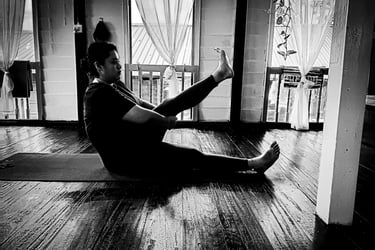Yoga for Inflammatory Arthritis
Footwear
One lifestyle factor that rarely gets the attention it deserves is footwear. Narrow, pointed toe boxes force the big toe inward; over time, this alters gait patterns and can accelerate joint strain, especially when paired with a pre-existing biomechanical imbalance in the hips or knees. Subtle changes in the nails, particularly of the toes, can also signal that a joint issue may be part of a wider systemic inflammatory condition.
Across research and clinical practice, three non-pharmaceutical tools consistently support inflammatory joint conditions: diet, movement, and biomechanics.
Diet
An anti-inflammatory, Mediterranean-style approach remains the most evidence-supported: plenty of vegetables, fruits, whole grains, olive oil, nuts, and oily fish. This neatly aligns with Ayurvedic guidance on “cooling foods”, helping the body calm its inflammatory response. Individual triggers vary - some people react more strongly to alcohol, ultra-processed foods, or excess sugar - so a little self-observation goes a long way.
Movement
Many people fear that exercise will make arthritis worse. In reality, the opposite is true. Cartilage receives nutrients through movement, and synovial fluid circulates with gentle pressure and release - much like squeezing and soaking a sponge. Yoga’s joint-loosening work is ideal because it offers:
Gentle, low-load movement
Systematic mobilisation without force
Better synovial fluid circulation
Sustained and regained range of motion
Improved neuromuscular control
The key is this: stay within a pain-free range of motion, especially during a flare. The objective is nourishment, not pushing.
Biomechanical Awareness
When there’s no major trauma, it’s worth examining footwear and gait. A wider toe box reduces crowding, allows the big toe to function properly, and can dramatically improve load distribution through the hips, knees, and ankles. It’s a small change with long-term impact.
In our classes, we often begin with ‘joint-loosening’ movements. These simple rotations do more than warm the body. They help nourish the tissues around the joints, encourage synovial lubrication, and support cartilage health. Done regularly, this kind of maintenance can help protect joint function over time.
Arthritis is commonly viewed as an issue of ageing and “wear and tear”, but inflammatory forms can affect people much younger. Genetics, previous joint injuries, biomechanical quirks, and lifestyle choices all influence how and when symptoms show up. Former athletes often recognise this the hard way.
A Practical Way Forward
These tools work best through consistency, not perfection. You don’t need to change everything at once. You could:
Swap to wider shoes
Add more colourful vegetables to meals
Commit to five minutes of joint rotations each morning
Small shifts compound into meaningful change, and your yoga practice can sit at the centre of it - steady, supportive, and sustainable.
Endnote: Individual needs vary, especially when medication is involved. If you’re managing inflammatory arthritis, it’s worth discussing dietary strategies, supplements, and exercise changes with your rheumatologist or healthcare provider, so your lifestyle adjustments complement your medical treatment.




More Insights
